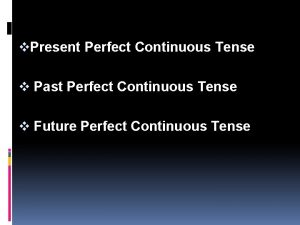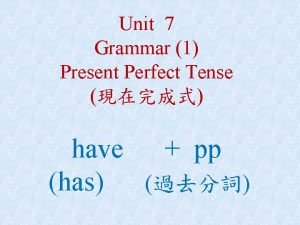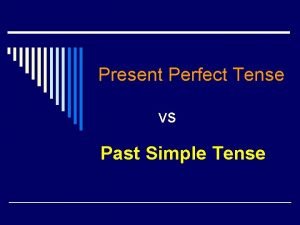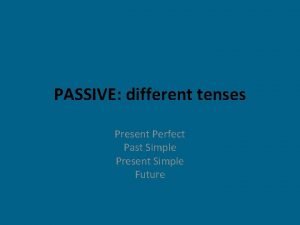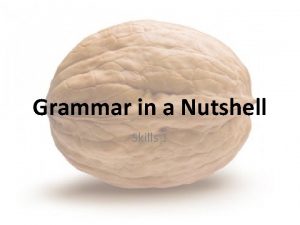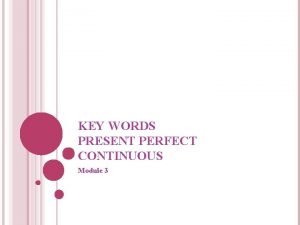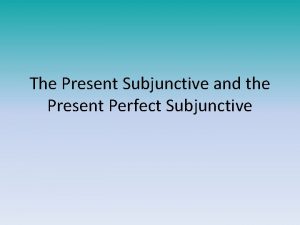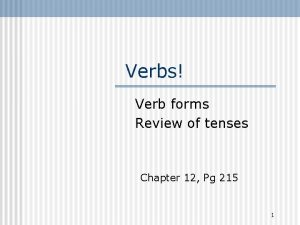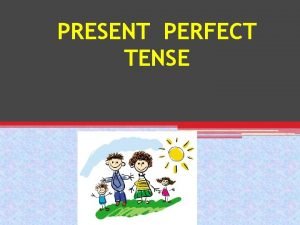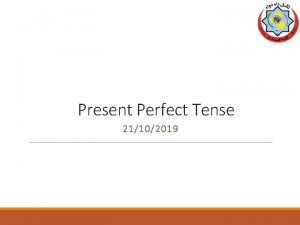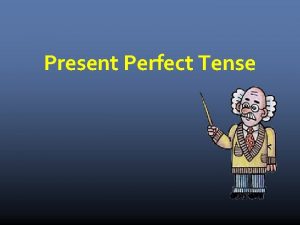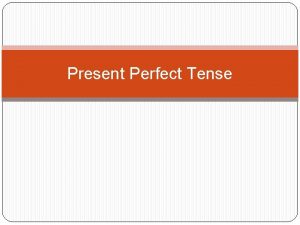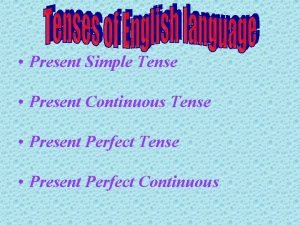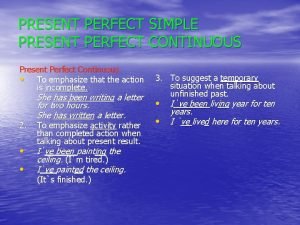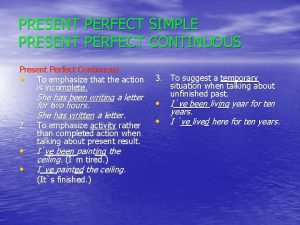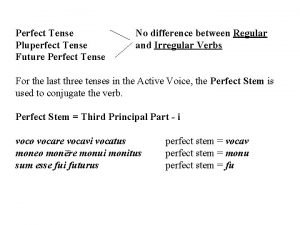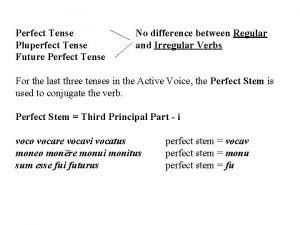Present Perfect Tense Cmo se dice en espaol























- Slides: 23

Present Perfect Tense

¿Cómo se dice en español? n She studies Spanish. n He studied Spanish. n We used to study Spanish. n They have studied Spanish.

PRESENT PERFECT TENSE The Present Perfect Tense is used to describe actions that “have” or “has” happened. (usually indicates rather recently) Ex. Julia has learned the verbs. Ex. We have told the truth.

PRESENT PERFECT TENSE n The Present Perfect Tense is a compound tense or has two verbs an auxiliary and main verb aka the participle. Ex. has told, have listened, has remained §When written, the Spanish verb must contain both verbs. Ex. Yo he hablado.

PRESENT PERFECT TENSE n The two parts of the Present Perfect Tense are: present tense of the verb haber + past participle Let’s look at each part more closely: §Haber is an auxiliary verb meaning “to have. ” §You cannot use it in place of “tener. ” §In the Present Perfect, haber must be accompanied by a past participle. §So how is it conjugated into the Present

PRESENT PERFECT TENSE n The present tense of haber is: he=I have _____ has= you have _____ (informal) ha= she has, you (formal) have _____ hemos=we have _______ habéis= you all have ______ (informal) han= they, you-all have (formal/informal) ____

PRESENT PERFECT TENSE n The second part is a past participle. n Forming a past participle is easy! 1. take an –AR infinitive 2. remove the –AR and add –ADO Ex. hablar=hablado (spoken/talked) Ex. viajar=viajado (traveled)

PRESENT PERFECT TENSE Take an –ER infinitive 2. remove the –ER and add –IDO Ex. comer=comido (eaten) Ex. aprender=aprendido (learned) 1. Take an –IR infinitive 2. remove the –IR and add –IDO Ex. vivir=vivido (lived) Ex. servir=servido (served) 1.

PRESENT PERFECT TENSE § Now, let’s put it all together… § Write the following example in your notebook. We have traveled to Spain. Nosotros hemos viajado a España.

PRESENT PERFECT TENSE § Una pregunta… Have you (Ud. ) listened to your teacher(m)? ¿Ud. ha escuchado a su profesor?

PRESENT PERFECT TENSE IRREGULAR PAST PARTICIPLES

PRESENT PERFECT TENSE § IRREGULAR PAST PARTICIPLES § The following irregular verbs have irregular past participles. You are responsible for learning the following: 1) escribir-escrito (to write) 8) romper-roto (to break) 2) volver-vuelto (to return) 9) descubrir-descubierto 3) poner-puesto (to put/place) (to discover) 4) ver-visto (to see) 10)morir-muerto (to die) 5) decir-dicho ( to say/tell) 11) resolver- resvuelto 6) hacer-hecho (to make/do) (to resolve) 7) abrir-abierto (to open)

PRESENT PERFECT TENSE § IRREGULAR PAST PARTICIPLES § Try the following examples using the irregular past participles: What have you (informal) done today? ¿Qué tú has hecho hoy?

PRESENT PERFECT TENSE § IRREGULAR PAST PARTICIPLES Why haven’t they returned? ¿Por qué ellos no han vuelto?

PRESENT PERFECT TENSE § IRREGULAR PAST PARTICIPLES What have you (Ud. ) made for us? ¿Qué Ud. nos ha hecho? or ¿Qué Ud. ha hecho para nosotros?

Tarea: Write the following in your notebook and translate into Spanish: Any learned tense could be there! 1. Mrs. Martez has put the dishes in the sink. She washed them. 2. Have you (informal) done your homework? I did my homework yesterday. 3. It was cold yesterday. We have not opened the windows. 4. They have been good students(f). Have you(Ud. ) been a good student? 5. I tried to listen to Mateo. He has not listened to me! 6. Have they(m) written the letter? They wrote the letter three days ago.

PRESENT PERFECT TENSE n. Present Perfect used with Reflexives

PRESENT PERFECT TENSE n Present Perfect with Reflexives: We have washed our hands this morning. Reflexive Pronouns are placed in front of the ENTIRE verb (both parts. )

PRESENT PERFECT TENSE n Present Perfect with Reflexives: Reflexive verbs have Reflexive Pronouns attached. Ex. lavarse

PRESENT PERFECT TENSE n Present Perfect with Reflexives-REMINDER Practice the following: 1. We have gone to bed very late. (acostarse=go to bed) 2. When have you brushed your hair? (cepillarse el pel 0=to brush your hair)

PRESENT PERFECT TENSE n Reflexive n me= Pronouns-QUICK Review myself n te=yourself n se=himself, herself, yourself (Ud. ) n nos=ourselves n se=themselves

PRESENT PERFECT TENSE n Reflexive Pronouns-QUICK Review n The Reflexive Pronouns are placed before the ENTIRE verb (both parts). n Ex. Ella se lava las manos. With a “no”…Ella no se lava las manos.

PRESENT PERFECT TENSE REMEMBER, YOU DO NOT HAVE TO RECALL THE REFLEXIVE VERBS BUT YOU MUST DEAL WITH THE PRONOUNS!
 Present perfect continuous irregular verbs
Present perfect continuous irregular verbs Present perfect tense vs present perfect continuous tense
Present perfect tense vs present perfect continuous tense Make in the present
Make in the present Present perfect with reflexive verbs
Present perfect with reflexive verbs Past perfect tense
Past perfect tense Present perfect
Present perfect Present perfect continuous auxiliary verb
Present perfect continuous auxiliary verb Present perfect tense past tense exercise
Present perfect tense past tense exercise Facts about tenses
Facts about tenses Futur simple english
Futur simple english Past simple present perfect present perfect continuous
Past simple present perfect present perfect continuous Past simple passive
Past simple passive Present perfect continuous time expression
Present perfect continuous time expression Present perfect indicative vs present perfect subjunctive
Present perfect indicative vs present perfect subjunctive Present tenses
Present tenses Difference between present perfect simple and continuous
Difference between present perfect simple and continuous Key words for present perfect continuous
Key words for present perfect continuous Present perfect subjunctive endings
Present perfect subjunctive endings Past simple present perfect present perfect continuous
Past simple present perfect present perfect continuous Perfect simple
Perfect simple When we use had been
When we use had been Past simple, past continuous and past perfect
Past simple, past continuous and past perfect Simple past present perfect and present perfect progressive
Simple past present perfect and present perfect progressive Three verb forms
Three verb forms






